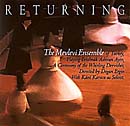Beken review, part two [See below for correct spelling of Turkish words not realizable in web text] |
|
 Returning:
The Music of the Whirling Dervishes Returning:
The Music of the Whirling DervishesInterworld, Thetford Center, VT, 1994, CD-916. Performers: The Mevlevi Ensemble of Turkey, directed by Dogan Ergin. Kâni Karaca, solo vocalist. Liner notes (4 pages) by Kabir Helminski. |
|
State-sponsored competitions of musical compositions in traditional forms (ilahi, ayin, etc.) begun during the 1970s instigated the creation of new examples of traditional music. The late ud performer and composer Cinuçen Tanrikorur, for example, won the Turkish Radio Television Award for his Beyatiaraban Ayin; Mutlu Torun and other composers won awards for their ilahi-s and other compositions in traditional forms. "Returning" features one of these new wave
traditional compositions, a Mevlevi ayin performed by the Mevlevi Ensemble of Turkey,
whose neyzenbasi (head ney player), Dogan Ergin, is the composer of the Ferahnak Asiran
suite heard on this recording, and the inventor of the makam Ferahnak Asiran. Ergin first
composed an ilahi in this makam in 1984 during a concert tour in New York. With the
encouragement of his colleagues and friends, he completed his Ferahnak Asiran Ayin in 1986
and it was performed the same year in Istanbul. A number of other
composers also showed interest in this new makam and used it in their original
compositions.[1] Although the program notes by Helminski say, "All compositions by Dogan Ergin," the pesrev introducing the ayin is composed by the eminent kanun player Cüneyd Kosal. |
|
pesrev, two hane
|
The form of this pesrev is in an older style; each hane (section) includes a brief teslim (short coda) rather than a longer mülazime (ritornello)[2]. Kosal's pesrev was not completely successful in blending the colors of the two distinct makams, Ferahnak and Asiran. [Audio 1] |
 score, opening page |
Ergin combines these two seemingly distant makams masterfully in his suite, starting with the first Selam. He also modulates to a number of other makams smoothly. |
Reminiscent of Münir Nurettin Selçuk's early 78 rpm records of the famous Beyati suite by H. Ismail Dede Efendi, master vocalist Karaca also performs the Ferahnak Asiran suite solo with the accompaniment of a large instrumental ensemble. He concludes this recording with another superb
performance of Quranic recitation. The notes in the four-page cover for
"Returning" are somewhat limited and Helminski seems to be unaware of the
dimensions of the makam phenomenon. For example, in describing the Ferahnak Asiran makam,
he states "the scale of the ayin on this recording called Ferahnak Asiran,"
reducing an extremely complicated makam to a mere scale. Subsequent
to these two CDs, commercially available recordings of this genre have been produced in
the U.S. and elsewhere.[3] In recording the Mevlevi Dervishes, we still
face some of the problems that we faced during the early years of recording technology. We
do not have to divide the large suite forms into different sections in order to fit the
performance on the record or adjust the tempi, nor do we see an awkward speeding up at the
end of a piece. The formal structure of the ayin suite, however, can still be compromised.
Hence, in order to fit a multimedia performance into an audio format, we are still missing
the important silences and the visual aspects of the Whirling Dervish ceremony. |
|
Münir Nurettin Beken Notes 1. For example, Hasan Esen's Saz
Semaisi, Cüneyd Kosal's Agir Aksak, Fethi Karamahmutoglu's Sengin Semai,
and Ümit Gürelman's Curcuna Sarki may be mentioned. [back] 2. This teslim is only twelve beats within the 56-beat Muzaaf Devri Kebir cycle, whereas a mulazime would take a full cycle. [back] 3. Kudsi Erguner, Nezih Uzel, and others
produced numerous recordings of ayins, including Suzidilara, Pençgah, Hicaz,
Acemasiran, Isfahan, Saba, and Beyati ayins. [back] Turkish orthography
|
|
|
|
